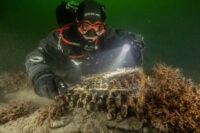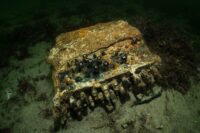 Divers working for the World Wide Fund for Nature (WWF) to remove fishing nets abandoned in the Baltic Sea caught a bigger fish than they expected: a World War II Enigma machine. It was on the seabed ensnared in a ghost net. The diver who first spotted it thought it was an old typewriter, but his colleague, underwater archaeologist Florian Huber, immediately suspected from the description that it was an Enigma machine. People don’t usually toss old typewriters overboard in the middle of the Baltic, while Enigmas were used by the German navy and certainly went down with ships and submarines. Two weeks later the two returned to the find site together and Huber confirmed that it was indeed an Enigma machine.
Divers working for the World Wide Fund for Nature (WWF) to remove fishing nets abandoned in the Baltic Sea caught a bigger fish than they expected: a World War II Enigma machine. It was on the seabed ensnared in a ghost net. The diver who first spotted it thought it was an old typewriter, but his colleague, underwater archaeologist Florian Huber, immediately suspected from the description that it was an Enigma machine. People don’t usually toss old typewriters overboard in the middle of the Baltic, while Enigmas were used by the German navy and certainly went down with ships and submarines. Two weeks later the two returned to the find site together and Huber confirmed that it was indeed an Enigma machine.
It was found on the bottom of Geltinger Bay where dozens of German U-boats were deliberately sunk by the German Navy in May of 1945. This machine is an M3 model with three rotors, so it must have come from a warship rather than a submarine as the U-boats were equipped with four-rotor M4 machines. The nameplate has yet to be deciphered. It won’t baldly state the name of the vessel it was on, but it will provide a clue to its history.
The Enigma enciphering machine was used by the German military to create and receive coded messages before and during the war. It used a system of rotors, lamps and plugboards to scramble text that would then be unscrambled by a receiving machine calibrated to the same settings — wheel order, rotor positions, plugboard connections — as the originating machine. The sequences were changed daily. The Polish Cipher Bureau was able to figure out the method of encryption before the war, but it was the codebreakers at Bletchley Park in Milton Keynes, especially mathematician Alan Turing, who finally broke Enigma in 1941. German forces kept adding rotors, plugs and lamps, increasing the level of difficulty, but they never realized that the Allies, armed with Colossus computers capable of calculating the daily key settings, could read their encrypted messages.
 Engima machines were produced in large quantities throughout the war. Approximately 100,000 of the machines were deployed, but most of them were discarded or destroyed. Today it’s rare to find an Enigma machine that is entirely original. The ones in museums are often Frankensteined together from several incomplete machines.
Engima machines were produced in large quantities throughout the war. Approximately 100,000 of the machines were deployed, but most of them were discarded or destroyed. Today it’s rare to find an Enigma machine that is entirely original. The ones in museums are often Frankensteined together from several incomplete machines.
The divers have reported the find to the Schleswig-Holstein State Office for Archeology which will study and conserve the Enigma for eventual display. The desalination process alone will take a year.
I put the surviving letters in an anagram generator, but it only produced 52 German words.
Not colossal.
😉
Not totally un-colossal, but yes, apparently the ‘L’ broke off, while at least the ‘A’ should have been on the right place 🙂
According to the rather detailed instructions on the specimen from the linked (history) blog post –three rotors or four– the machine was not totally bulletproof to operate, and the lubrication of certain parts, i.e. while non-lubricate certain others, seems to have been key. The spot is “Gelting Bay” (Germ.: Geltinger Bucht, Dan.: Gelting Bugt) in Flensburg Fjord between the German and Danish shores.
Within family and friends, I know of three people, who took part in the war on the German side. I have the complete logs of one of them, who in 1943/44 defused 243 unexploded Allied bombs in and around Berlin: His very first one went off, which he survived behind a heap of sand. He was court-martialled, had to declare himself, and carried on. His best buddy salvaged in Italy from a sunken U-boat on at least two occasions.
The typewritten report from somebody in the 1960s tells a different story: The third one –whom I did not know in person– was apparently killed in March 1945 near Gdansk, which by then was surrounded by the advancing Soviet Army. According to the notes, his identification tag was that of the “Stuka 2/186” unit, and so far I was unable to find out, if he had been within or outside the surrounded city.